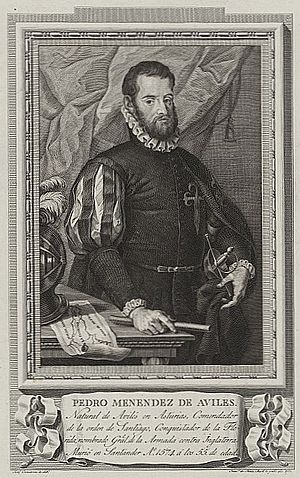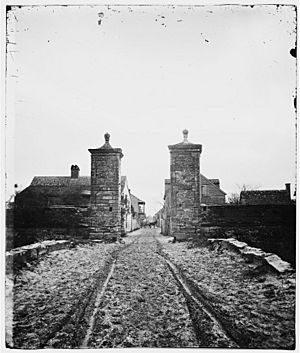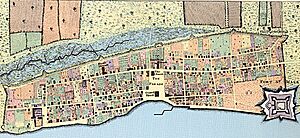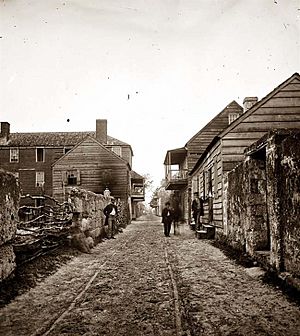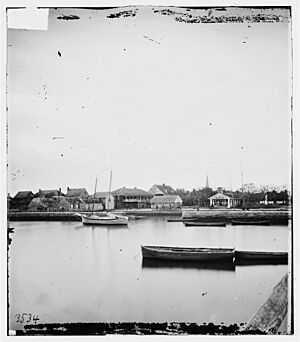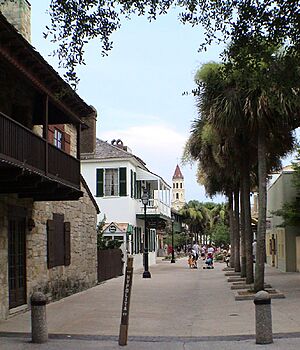History of St. Augustine, Florida facts for kids
Quick facts for kids History of Florida |
|
|---|---|
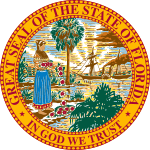
The seal of Florida reflects the state's Native American ancestry
|
|
| Historical Periods | |
| Pre-history | until 1497 |
| Spanish Rule | 1513–1763 |
| British Rule | 1763–1783 |
| Spanish Rule | 1783–1821 |
| U.S. Territorial Period | 1822–1845 |
| Statehood | 1845–present |
| Major Events | |
| American Revolutionary War | 1775–1783 |
| War of 1812 | 1811–1814 |
| First Seminole War | 1817–1818 |
| Capitol moved to Tallahassee |
1824 |
| Second Seminole War | 1835–1842 |
| Constitutional convention | 1838 |
| Third Seminole War | 1855–1858 |
| Ordinance of Secession | 1861 |
| Civil War | 1861–1865 |
| 3rd Constitution | 1865 |
| Reconstruction | 1865–1868 |
| 4th Constitution | 1868 |
| 5th Constitution | 1885 |
| Great Migration | 1910–1930 |
| Land Boom | 1925–1929 |
| 6th Constitution | 1968 |
| Gore v. Harris 2000 Presidential Election |
2000 |
| Timeline | |
St. Augustine, Florida is the oldest city in the United States that was continuously settled by Europeans. It was founded in 1565 by a Spanish admiral named Pedro Menéndez de Avilés. The King of Spain, Philip II, gave Menéndez special permission to explore and settle a large area called La Florida.
The main goal was to create a permanent colony. This colony would help protect Spain's valuable treasure ships. It would also keep other European countries from taking over Spanish lands in North America.
Contents
Early Explorers and First Settlements
The first European to explore Florida's coasts was Juan Ponce de León in 1513. He was a Spanish explorer and governor of Puerto Rico. He probably sailed near where St. Augustine is today. He named the land "La Florida" and claimed it for Spain.
Before St. Augustine was founded in 1565, both Spain and France tried to start colonies in Florida. But all these early attempts failed.
French exploration began in 1562 with Captain Jean Ribault. He explored the St. Johns River north of St. Augustine. He then sailed further north and started a short-lived fort called Charlesfort in South Carolina. In 1564, Ribault's friend, René Goulaine de Laudonnière, led a new French effort. He explored the St. Augustine area and met the local Timucua people. They then built Fort Caroline further north.
Later, some French soldiers from Fort Caroline became pirates. They attacked Spanish ships. Spain used this as an excuse to destroy Fort Caroline. King Philip II sent Pedro Menéndez de Avilés to Florida to attack the French.
Founding of St. Augustine
Pedro Menéndez's ships first saw land on August 28, 1565. This was the feast day of a saint named Augustine of Hippo. So, Menéndez named his new settlement San Agustín (St. Augustine). The Spanish sailed into Matanzas Bay and landed near a Timucua village on September 6. Menéndez quickly built defenses to protect his people and supplies.
Archaeologists have found the location of this first fort. It is now part of the Fountain of Youth Archaeological Park. The Spanish used some Native American buildings in the Timucua village.
Meanwhile, Jean Ribault, the French commander, arrived at Fort Caroline with more settlers and soldiers. He planned to attack St. Augustine. But a huge storm wrecked his ships further south. This gave Menéndez a chance. He marched his soldiers overland and launched a surprise attack on Fort Caroline. The Spanish killed most of the French soldiers, but spared the women and children. Menéndez renamed the fort "San Mateo."
The Spanish then went south and found the survivors of Ribault's wrecked fleet. Menéndez executed most of them, including Ribault. This area has been called Matanzas ever since, which is Spanish for "slaughters."
In 1566, Martín de Argüelles was born in St. Augustine. He was the first child of European parents born in what is now the continental United States. This was 21 years before the English settlement at Roanoke Island. In 1606, the first recorded birth of a black child in the continental United States happened here. This was 13 years before enslaved Africans arrived in Jamestown.
Spanish Rule
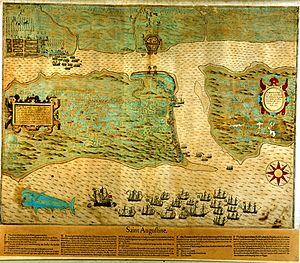
St. Augustine was meant to be a base for Spain to expand its control. But Native Americans in the area were not interested in becoming Spanish subjects. The Saturiwa, a powerful Native American group, remained hostile. In 1566, the Saturiwa burned St. Augustine. The settlement was moved to its current location by the end of the 1500s.
The city also faced attacks from other European countries. In 1568, a French soldier named Dominique de Gourgue attacked Fort San Mateo (the former Fort Caroline). He was helped by Native American groups who had been friendly with the French. De Gourgues burned the fort and killed his prisoners. But he did not attack St. Augustine itself.
On June 6, 1586, an English privateer named Sir Francis Drake attacked St. Augustine. He burned the city and forced the Spanish settlers to flee. However, Drake did not have enough soldiers to start an English settlement. He left the area and sailed north.
In 1668, another English privateer, Robert Searle, attacked and robbed St. Augustine. After this raid, the Spanish began building a stronger fort in 1672. This fort was called the Castillo de San Marcos. It is the oldest fort in the United States today. Its construction took 25 years.
Spain did not bring many enslaved people to Florida. This was because Florida was mainly a military outpost, not a place with large farms. As the British settled colonies to the south, Spain offered freedom to enslaved people who escaped to Florida. If they became Catholic and promised loyalty to the King of Spain, they would be free. St. Augustine became a major destination for runaway enslaved people.
By 1683, a group of free black people formed a militia unit to defend St. Augustine. Many of them had ancestors from Spain. This militia helped improve their standing in society.
The British founded Charleston in 1670 and Savannah in 1733. In response, the Spanish governor created the first legally recognized free community of former enslaved people in 1738. This community was called Gracia Real de Santa Teresa de Mose, or Fort Mose. It was two miles north of St. Augustine and served as a defensive outpost.
In 1740, British forces attacked St. Augustine. The largest attack was led by Governor James Oglethorpe of Georgia. He got help from the Seminole tribe. Oglethorpe invaded Spanish Florida and tried to capture St. Augustine. During this attack, the black community of St. Augustine played an important role in defending the city. The leader of Fort Mose was Captain Francisco Menendez. He had escaped slavery twice. The Fort Mose site is now a National Historic Landmark.
British Rule
In 1763, the Treaty of Paris ended the Seven Years' War. Spain gave Florida and St. Augustine to the British. In return, the British gave up control of Havana, Cuba. Most Spanish Floridians and many freed people left St. Augustine for Cuba.
James Grant became the first British governor of East Florida. He served from 1764 to 1771. He was replaced by Patrick Tonyn. During this time, the British turned a former monastery into military barracks called St. Francis Barracks. They also built The King's Bakery, which is the only building in the city built entirely during the British period.
During the American Revolutionary War, St. Augustine remained loyal to the British.
In 1768, Andrew Turnbull started a settlement called New Smyrna. He brought workers from the Mediterranean area, especially the island of Minorca. Conditions at New Smyrna were very bad. In 1777, the settlers rebelled and walked 70 miles to St. Augustine. Governor Tonyn gave them shelter. The Minorcans and their families stayed in St. Augustine. They added to the city's language, culture, and customs.
Second Spanish Rule
The Treaty of Paris in 1783 ended the American Revolutionary War. This treaty gave the American colonies their independence. It also gave Florida back to Spain because Spain had helped the American colonies.
Florida was under Spanish control again from 1784 to 1821. There was not much new settlement. The forts slowly fell apart. Spain itself was at war during some of this time and had little control over Florida. In 1821, the Adams–Onís Treaty peacefully gave Florida and St. Augustine to the United States. Only three Spanish soldiers were stationed there in 1821.
A reminder of this second Spanish period is the Constitution monument in the town plaza. It is an obelisk honoring the Spanish Constitution of 1812. This was a very modern constitution for its time. In 1814, the King of Spain got rid of this constitution and had monuments to it torn down. The one in St. Augustine is said to be the only one that survived.
American Period
Spain gave Florida to the United States in 1821. Florida officially became a U.S. territory in 1822. Andrew Jackson was appointed its military governor. Florida became a U.S. state in 1845.
After 1821, the United States renamed the Castillo de San Marcos "Fort Marion." This was in honor of Francis Marion, a hero of the American Revolution.
During the Second Seminole War (1835–42), the fort was used as a prison for Seminole captives. This included the famous leader Osceola. The city had militia units that fought in the war.
In 1861, the American Civil War began. Florida left the Union and joined the Confederacy. Local soldiers took control of Fort Marion and the St. Francis Barracks. But on March 11, 1862, U.S. Navy forces easily took back the city. The fort was used for Union soldiers to recover. The Confederates never tried to retake the city. In 1865, Florida rejoined the United States.
After the war, formerly enslaved people in St. Augustine created the community of Lincolnville in 1866. It was named after President Abraham Lincoln. Lincolnville has many old Victorian Era homes. It became very important during the Civil Rights Movement a century later.
After the Civil War, Fort Marion was used to hold Native American prisoners. This included Plains Indians and Apaches. Geronimo's daughter was born at Fort Marion. The fort was also a military prison during the Spanish–American War in 1898. It was removed from active military duty in 1900. In 1933, the National Park Service took over the fort. In 1942, Fort Marion went back to its original name, Castillo de San Marcos. It is now a National Historic Landmark.
The Flagler Era

Henry Flagler, a very rich businessman, came to St. Augustine in the 1880s. He helped turn the city into a winter resort for wealthy people from the North. Flagler bought several local railroads. He combined them into the Florida East Coast Railway, which had its main office in St. Augustine.
Flagler hired architects to design many grand buildings in St. Augustine. These included the Ponce de León Hotel and the Alcazar Hotel. Flagler also built or helped build several churches. He was buried in the beautiful Memorial Presbyterian Church after his death in 1912.
Flagler also had a baseball park built in St. Augustine. In the 1880s, the waiters at his hotels formed one of America's first professional black baseball teams, the Ponce de Leon Giants.
In 1888, Flagler helped open the Alicia Hospital. It was the only public hospital between Daytona Beach and Jacksonville. It was renamed Flagler Hospital in his honor in 1905.
The St. Augustine Alligator Farm, founded in 1893, is one of Florida's oldest tourist attractions. The Fountain of Youth Archaeological Park also became a tourist spot around 1902. St. Augustine is the eastern end of the Old Spanish Trail. This was a 3,000-mile road system from the 1920s that connected St. Augustine to San Diego, California.
From 1918 to 1968, St. Augustine was home to the Florida Normal and Industrial Institute. This school served African American students. During World War II, St. Augustine hotels were used to train Coast Guardsmen.
The Florida land boom of the 1920s led to the development of Davis Shores. This was a new neighborhood on Anastasia Island. It was connected to downtown St. Augustine by the Bridge of Lions.
Civil Rights Movement
St. Augustine was a very important place for the civil rights movement in 1963–64.
Even after the Supreme Court ruled that school segregation was illegal, African Americans in St. Augustine still faced challenges. They tried to integrate public schools and places like lunch counters. They were often arrested or met with violence from the Ku Klux Klan. Peaceful protesters were put in jail. Black homes were firebombed, and leaders were threatened.
In the spring of 1964, Robert Hayling, a local civil rights leader, asked Martin Luther King Jr. for help. From May to July 1964, they led marches, sit-ins, and other peaceful protests in St. Augustine. Hundreds of civil rights supporters, both black and white, were arrested. Jails became full. White supporters from the North, including students and religious leaders, came to St. Augustine and were arrested with Southern activists.
The Ku Klux Klan responded with violent attacks. These attacks were shown in national and international news. People across the country were shocked by the Klan's violence. This public outrage helped lead to the passage of the Civil Rights Act of 1964. This law helped protect the rights of all Americans.
The Florida Normal Industrial and Memorial College, whose students had joined the protests, felt unwelcome in St. Augustine. In 1968, it moved to Dade County. Today it is Florida Memorial University.
In 2010, a movie called Crossing in St. Augustine was shown. It was about the civil rights struggles in the city. Andrew Young, a civil rights leader who was beaten in St. Augustine in 1964, was in the movie.
The city has a Freedom Trail of historic civil rights sites. There is also a museum at the Fort Mose site, the location of the free black community. Historic Excelsior School, built in 1925, is now the city's first museum of African-American history. In 2011, the St. Augustine Foot Soldiers Monument was dedicated in the downtown plaza. It honors those who participated in the civil rights movement. Another part of the plaza was named "Andrew Young Crossing" to honor the civil rights leader. Bronze footprints and quotes are part of the sidewalk there.
Modern Era
Today, St. Augustine is a popular place for tourists from the United States, Canada, and Europe. The city has many well-preserved Spanish-style buildings. It also has architecture from the 1700s and 1800s. St. Augustine is easy to explore on foot. It has several parks along the ocean. The mild weather allows for tourism all year round. Many tour companies offer walking and trolley tours.
Architecture and Points of Interest
The city's historic center is focused around St. George Street. This street has historic houses from different time periods. Some of these houses have been rebuilt, but many are original buildings that have been restored. The city has many beautiful examples of Spanish-style, Mediterranean Revival, British Colonial, and early American homes.
The Castillo de San Marcos is on South Castillo Drive. It is the oldest stone fort in the continental United States. It is made of a special type of limestone called coquina. Building started in 1672. The fort became a National Monument in 1924. After 251 years of military use, it was no longer an active fort in 1933. Today, the nearly 350-year-old fort is a popular place for visitors. It is run by the National Park Service.
One of St. Augustine's most famous buildings is the former Ponce de Leon Hotel. It is now part of Flagler College. Henry M. Flagler built this hotel. It was finished in 1888. This fancy hotel was designed in the Spanish Renaissance style. Wealthy people from the North stayed there during the winter.
The city also has one of the oldest alligator farms in the United States. It opened on May 20, 1893. Today, the St. Augustine Alligator Farm Zoological Park teaches people about alligators and crocodiles. It is the only place in the United States where you can see every type of alligator, crocodile, caiman, and gharial.
Five statues in St. Augustine are part of a special system called TOUCH (Tactile Orientation for Understanding Creativity and History) St. Augustine Braille Trail. This system helps both blind and sighted people learn about the statues. The statues are of Pedro Menéndez, Juan Ponce de León, the St. Augustine Foot Soldiers, Henry Flagler, and Father Pedro Camps. The system includes an audio tour that can be accessed by phone or smart device.


